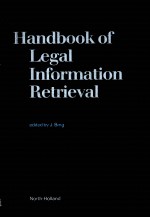图书介绍
Handbook of Legal Information RetrievalPDF|Epub|txt|kindle电子书版本网盘下载

- 著
- 出版社: Elsevier Science Ltd
- ISBN:9780444875761;044487576X
- 出版时间:1984
- 标注页数:580页
- 文件大小:20MB
- 文件页数:598页
- 主题词:
PDF下载
下载说明
Handbook of Legal Information RetrievalPDF格式电子书版下载
下载的文件为RAR压缩包。需要使用解压软件进行解压得到PDF格式图书。建议使用BT下载工具Free Download Manager进行下载,简称FDM(免费,没有广告,支持多平台)。本站资源全部打包为BT种子。所以需要使用专业的BT下载软件进行下载。如BitComet qBittorrent uTorrent等BT下载工具。迅雷目前由于本站不是热门资源。不推荐使用!后期资源热门了。安装了迅雷也可以迅雷进行下载!
(文件页数 要大于 标注页数,上中下等多册电子书除外)
注意:本站所有压缩包均有解压码: 点击下载压缩包解压工具
图书目录
PART Ⅰ: Legal decision and communication processes1
1 Context of retrieval systems3
2 Decision processes6
2.1 Introduction6
2.2 Initiation7
2.3 The facts of the case10
2.3.1 The probable facts of the case10
2.3.2 The proven facts of the case11
2.4 Legal sources13
2.5 The retrieval process18
2.6 Interpretation: Relationsbetween sources and norms26
2.6.1 Relevancy of sources weight of arguments26
2.6.2 Words and uncertainty30
2.6.3 Harmonization34
2.7 The normative interval37
2.8 The result and feedback from the result40
2.9 Standards for legal information retrieval44
3 Communication processes50
3.1 Introduction50
3.2 The editorial process: Data base selection52
3.2.1 Introduction52
3.2.2 Selection54
3.2.3 The data base59
(1) Representativity59
(2) Objectivity63
(3) Updating66
3.3 The editorial process: Document design69
3.3.1 Documents69
3.3.2 Three typical forms of documents74
(1) Indexes74
(2) Abstracts79
(3) Authentic text83
3.3.3 Functional performance84
(1) Introduction84
(2) The retrieval function86
(3) The relevance function93
(4) The source function97
(5) The current awarness function100
3.3.4 Conclusions102
3.4 The information system105
3.4.1 Elements of the information system105
3.4.2 Information - and on what106
(1) The concept of information106
(2) The subject of information109
3.5 Using the information system113
3.5.1 User-constructed information systems113
3.5.2 Availability factors115
(1) Introduction115
(2) Pragmatic and formal availablity factors117
(3) User research on availability factos: An example118
3.5.2 The cost curve120
(1) Area of interest -area of documentation120
(2) The local data base: The concept of coverage122
(3) Factors determinig the cost curve125
(4) Availability discrimination129
3.5.4 Active and passive use ofinformation systems131
(1) Introduction131
(2) Functional performance133
(3) Delegation135
3.5.5 Technological change and costs137
PART Ⅱ: Text retrieval141
4 Anatomy of text retrieval143
4.1 Introduction143
4.1.1 Defining an informationretrieval system143
4.1.2 Sketch of an informationretrieval system145
4.1.3 Different user situations148
4.2 Characteristics of text retrieval151
4.2.1 Document retrieval151
4.2.2 Full text retrieval151
4.2.3 Interest retrieval152
4.3 The retrieval process154
4.4 Choosing the data base157
4.5 Retrieval strategies160
4.5.1 Introduction160
4.5.2 The retrieval function160
(1) Simulating relevanceassessment160
(2) Identity functions161
(3) Nearness functions164
(4) Combinations of identityand nearness functions173
4.5.3 Iterative techniques175
(1) Introduction175
(2) Relevance feedback176
(3) Local metrical feedback177
(4) Computerized processing of search requests snowball functions178
(5) A preprocessor to textretrieval systems178
4.6 Aids in formulating search requests180
4.6.1 Formulating the request180
4.6.2 Examples of different aids181
(1) Truncation181
(2) Mask functions182
(3) Automatic stemming182
(4) Thesaurus182
4.6.3 Choosing the level of performance183
4.7 Examples of file structures185
4.7.1 Inverted file structure185
4.7.2 Vector based systems189
4.8 Appendix I: Some important textretrieval systems190
4.9 Appendix II: The concept of relevance197
4.9.1 Types of relevance: Formal,content, and subjectiverelevance197
4.9.2 The nature of relevance: Absolute and relative relevance199
4.9.3 The grading of relevance: Grading by degrees or binary grading?199
4.9.4 The relevance concept as used in this book202
5 Research regarding the performance and design of text retrieval systems204
5.1 Introduction204
5.2 General research207
5.2.1 The Aslib-Cranfield projects: 1960-1966207
5.2.2 The SMART project: 1964-1983209
5.2.3 The MEDLARS evaluation: 1966-1967214
5.2.4 The"Comparative SystemsLaboratory Experiments"Projects: 1963-1968217
5.3 Development and design of text etrieval systems218
5.3.1 The CONDOR project: 1973-1981220
5.3.2 The SPIRIT system222
5.4 Research regarding legal systems226
5.4.1 The joint ABF/IBM project: 1966-1967226
5.4.2 The Oxford experiments: 1963-1965, 1976-1982227
5.4.3 The Responsa project: 1967-1983230
5.4.4 The WIENER SYSTEM233
5.4.5 The MAJUS program:1974-1977235
5.4.5 The NORIS research program:1972-1983236
PART Ⅲ: International survey of legal information retrieval247
6 A brief history of computerized information retrieval249
6.1 Introduction249
6.2 Background251
6.2.1 Libraries and indexes251
6.2.2 Jurimetrics253
6.3 The initiative257
6.3.1 The Pittsburgh project257
6.3.2 The Aspen Systems Corporation260
6.3.3 The Oxford experiments264
6.4 Aprofusion of projects264
6.4.1 Introduction264
6.4.2 Law Research Services,Inc265
6.4.3 RIRA: Reports and Information Retrieval Activity268
7 Current information systems272
7.1 International organizations272
7.1.1 Introduction272
7.1.2 Intergovernmental Bureau of Informatics273
7.1.3 The Council of Europe274
7.1.4 The European Communities278
7.1.5 EURONET DIANE285
7.1.6 World Health Organization286
7.1.7 INTERDOC286
7.2 Argentina288
7.3 Australia289
7.3.1 Introduction289
7.3.2 The SCALE project290
7.3.3 Future developments in Australia292
7.4 Austria294
7.5 Belgium298
7.5.1 Introduction298
7.5.2 CREDOC299
7.5.3 JUSTEL305
7.5.4 Samsom307
7.6 Brazil309
7.7 Canada311
7.7.1 Introduction311
7.7.2 Quebec:from DATUM to SOQULJ314
7.7.3 From QULC/LAW to QT.Systems322
7.7.4 Carswell Legal publicaions330
7.8 Denmark331
7.8.1 Introduction331
7.8.2 DC-jura333
7.8.3 DATA LEX335
7.9 Finland337
7.10 France341
7.10.1Introduction341
7.10.2IRETIJ345
7.10.3CEDIJ350
7.10.4SYDONI356
7.10.5JURIS-DATA359
7.10.6LEXIS360
7.10.7Specialized or regionalinformation systems361
7.11 Germany367
7.11.1 Introduction367
7.11.2 JURIS373
(1) Introduction373
(2) JURIS pilot system376
(3) Extended JURIS system382
7.11.3 DATEV384
7.12 Greece388
7.13 Holland390
7.13.1 Introduction390
7.13.2 Kluwer JURID391
7.13.3 The PARAC - Vermande project393
7.14 Ireland395
7.15 Israel396
7.16 Italy397
7.16.1 Introduction397
7.16.2 ITALGIURE399
7.16.3 Istituto per la documentazione giurdica408
7.16.4 Camera dei deputati409
7.17 Japan412
7.18 Luxemburg413
7.19 Mexico414
7.19.1 Introduction414
7.19.2 UNAM-JURE414
7.20 New Zealand416
7.21 Norway418
7.21.1 Introduction418
7.21.2 Lawdata422
7.22 Spain427
7.23 Sweden429
7.23.1 Introduction429
7.23.2 From RI to Raettsdata431
7.24 Switzerland440
7.25 United Kingdom441
7.25.1 Introduction441
(1) The STATUS project441
(2) The Society for Computers and Law443
(3) Universities and research institutions445
(4) A note on unreported cases449
7.25.2 LEXIS452
7.25.3 EUROLEX456
7.25.4 Prestel services461
(1) Infolex461
(2) Lawtel462
7.25.5 Northcrn lreland-and the BTRD systems464
7.26 United stathcrn of America467
7.26.1 Lntroduction467
7.26.2 From LlTE to FLITE473
7.26.3 JURIS:Justice RetrievaI and Inquiery system476
7.26.4 LEXIS484
7.26.5 WESTLAW497
Literature505
Alphabctical index533
Index to figures and tables57
Fig 3/1 - Relations between the data bases of three different information systems with identical documentation areas57
Fig 3/2 - Relations beweenpublication ratio and representativity62
Fig 3/3 - Average recall-precision curves for three different types of documents92
Fig 3/4 - Relevance assessment based on abstracts96
Fig 3/5 - Document types and system functions102
Fig 3/6 - Document design and system functions103
Fig 3/7 - Causes for missing information119
Fig 3/8 - Typical cost curve for use of information services in an average case - elbow indicating "local data base"123